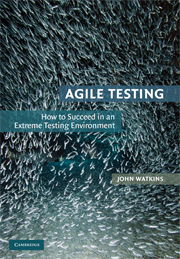Book contents
- Frontmatter
- Contents
- Foreword by Bob Bartlett
- Acknowledgments
- 1 Introduction
- PART 1 REVIEW OF OLD-SCHOOL AND AGILE APPROACHES
- PART 2 EVERYONE IS DIFFERENT: AGILE CASE STUDIES
- 4 From Waterfall to Evolutionary Development and Test
- 5 How to Test a System That Is Never Finished
- 6 Implementing an Agile Testing Approach
- 7 Agile Testing in a Remote or Virtual Desktop Environment
- 8 Testing a Derivatives Trading System in an Uncooperative Environment
- 9 A Mixed Approach to System Development and Testing: Parallel Agile and Waterfall Approach Streams within a Single Project
- 10 Agile Migration and Testing of a Large-Scale Financial System
- 11 Agile Testing with Mock Objects: A CAST-Based Approach
- 12 Agile Testing – Learning from Your Own Mistakes
- 13 Agile: The Emperor's New Test Plan?
- 14 The Power of Continuous Integration Builds and Agile Development
- 15 The Payoffs and Perils of Offshored Agile Projects
- 16 The Basic Rules of Quality and Management Still Apply to Agile
- 17 Test-Infecting a Development Team
- 18 Agile Success Through Test Automation: An eXtreme Approach
- 19 Talking, Saying, and Listening: Communication in Agile Teams
- 20 Very-Small-Scale Agile Development and Testing of a Wiki
- 21 Agile Special Tactics: SOA Projects
- 22 The Agile Test-Driven Methodology Experiment
- 23 When Is a Scrum Not a Scrum?
- PART 3 AGILE MY WAY: A PROPOSAL FOR YOUR OWN AGILE TEST PROCESS
- APPENDIX A The Principles of Rapid Application Development
- APPENDIX B The Rules and Practices of Extreme Programming
- Appendix C The Principles of the Dynamic Systems Development Method
- Appendix D The Practices of Scrum
- APPENDIX E Agile Test Script Template
- Appendix F Agile Test Result Record Form Template
- Appendix G Agile Test Summary Report Template
- Appendix H My Agile Process Checklist
- References
- Index
14 - The Power of Continuous Integration Builds and Agile Development
Published online by Cambridge University Press: 26 October 2009
- Frontmatter
- Contents
- Foreword by Bob Bartlett
- Acknowledgments
- 1 Introduction
- PART 1 REVIEW OF OLD-SCHOOL AND AGILE APPROACHES
- PART 2 EVERYONE IS DIFFERENT: AGILE CASE STUDIES
- 4 From Waterfall to Evolutionary Development and Test
- 5 How to Test a System That Is Never Finished
- 6 Implementing an Agile Testing Approach
- 7 Agile Testing in a Remote or Virtual Desktop Environment
- 8 Testing a Derivatives Trading System in an Uncooperative Environment
- 9 A Mixed Approach to System Development and Testing: Parallel Agile and Waterfall Approach Streams within a Single Project
- 10 Agile Migration and Testing of a Large-Scale Financial System
- 11 Agile Testing with Mock Objects: A CAST-Based Approach
- 12 Agile Testing – Learning from Your Own Mistakes
- 13 Agile: The Emperor's New Test Plan?
- 14 The Power of Continuous Integration Builds and Agile Development
- 15 The Payoffs and Perils of Offshored Agile Projects
- 16 The Basic Rules of Quality and Management Still Apply to Agile
- 17 Test-Infecting a Development Team
- 18 Agile Success Through Test Automation: An eXtreme Approach
- 19 Talking, Saying, and Listening: Communication in Agile Teams
- 20 Very-Small-Scale Agile Development and Testing of a Wiki
- 21 Agile Special Tactics: SOA Projects
- 22 The Agile Test-Driven Methodology Experiment
- 23 When Is a Scrum Not a Scrum?
- PART 3 AGILE MY WAY: A PROPOSAL FOR YOUR OWN AGILE TEST PROCESS
- APPENDIX A The Principles of Rapid Application Development
- APPENDIX B The Rules and Practices of Extreme Programming
- Appendix C The Principles of the Dynamic Systems Development Method
- Appendix D The Practices of Scrum
- APPENDIX E Agile Test Script Template
- Appendix F Agile Test Result Record Form Template
- Appendix G Agile Test Summary Report Template
- Appendix H My Agile Process Checklist
- References
- Index
Summary
SYNOPSIS
This case study will examine how organizations can benefit from applying continuous integration build (CIB) solutions; it will also look at how adopting agile best practices can increase development productivity while introducing performance management techniques, as well as examining the role and use of testing throughout CIB.
Introduction
My name is James Wilson and I am the CEO of Trinem, based in Edinburgh, United Kingdom. I cofounded Trinem with Philip Gibbs in 2001 after working for a number of years as an IT consultant, primarily delivering software configuration management (SCM) services and solutions. Since 2001, Trinem has implemented SCM projects that have inherited various forms of technologies, methods, and scale.
Trinem has implemented processes, and had their technology implemented, for a wide spectrum of organizations, including NASA (United States), Bank of New York (United Kingdom), HBOS (United Kingdom), Belastingdienst (Holland), Syscom (Taiwan), SDC (Denmark), and GE (United Kingdom and Holland).
This case study illustrates the challenges, approaches, and benefits that I have encountered while developing agile application development processes.
This case study will also explore some of the key technologies that were used, both commercial and open source, to augment the implementations delivered by Trinem and myself.
Agile, Extreme Programming, Scrum, and/or Iterative?
Invariably when customers ask for consulting services to assist with the implementation of SCM and application development best practices, they already have an idea of what is happening in the industry.
- Type
- Chapter
- Information
- Agile TestingHow to Succeed in an Extreme Testing Environment, pp. 93 - 102Publisher: Cambridge University PressPrint publication year: 2009



